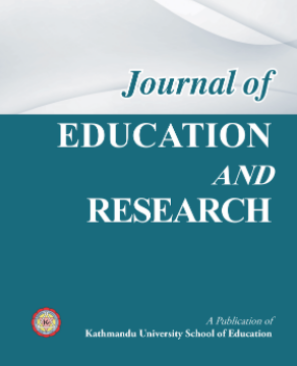
Schooling: The Way People See It
Original Article
Journal of Education and Research, Volume 1, Issue 1, 2008, 31-40, https://doi.org/10.3126/jer.v1i0.7949
Publication date: Apr 17, 2008
Views: 382 | Downloads: 184
How to cite this article
APA
In-text citation: (Parajuli, 2008)
Reference: Parajuli, M. N. (2008). Schooling: The Way People See It. Journal of Education and Research, 1(1), 31-40. https://doi.org/10.3126/jer.v1i0.7949
Reference: Parajuli, M. N. (2008). Schooling: The Way People See It. Journal of Education and Research, 1(1), 31-40. https://doi.org/10.3126/jer.v1i0.7949
Vancouver
In-text citation: (1), (2), (3), etc.
Reference: Parajuli MN. Schooling: The Way People See It. Journal of Education and Research. 2008;1(1):31-40. https://doi.org/10.3126/jer.v1i0.7949
Reference: Parajuli MN. Schooling: The Way People See It. Journal of Education and Research. 2008;1(1):31-40. https://doi.org/10.3126/jer.v1i0.7949
AMA
In-text citation: (1), (2), (3), etc.
Reference: Parajuli MN. Schooling: The Way People See It. Journal of Education and Research. 2008;1(1), 31-40. https://doi.org/10.3126/jer.v1i0.7949
Reference: Parajuli MN. Schooling: The Way People See It. Journal of Education and Research. 2008;1(1), 31-40. https://doi.org/10.3126/jer.v1i0.7949
Chicago
In-text citation: (Parajuli, 2008)
Reference: Parajuli, Mahesh Nath. "Schooling: The Way People See It". Journal of Education and Research 2008 1 no. 1 (2008): 31-40. https://doi.org/10.3126/jer.v1i0.7949
Reference: Parajuli, Mahesh Nath. "Schooling: The Way People See It". Journal of Education and Research 2008 1 no. 1 (2008): 31-40. https://doi.org/10.3126/jer.v1i0.7949
Harvard
In-text citation: (Parajuli, 2008)
Reference: Parajuli, M. N. (2008). Schooling: The Way People See It. Journal of Education and Research, 1(1), pp. 31-40. https://doi.org/10.3126/jer.v1i0.7949
Reference: Parajuli, M. N. (2008). Schooling: The Way People See It. Journal of Education and Research, 1(1), pp. 31-40. https://doi.org/10.3126/jer.v1i0.7949
MLA
In-text citation: (Parajuli, 2008)
Reference: Parajuli, Mahesh Nath "Schooling: The Way People See It". Journal of Education and Research, vol. 1, no. 1, 2008, pp. 31-40. https://doi.org/10.3126/jer.v1i0.7949
Reference: Parajuli, Mahesh Nath "Schooling: The Way People See It". Journal of Education and Research, vol. 1, no. 1, 2008, pp. 31-40. https://doi.org/10.3126/jer.v1i0.7949
ABSTRACT
In this paper, I discuss how people perceive and give meaning to schooling or education. Based largely on field-data, I organize this discussion on four key themes social status and employment, everyday skills and knowledge, gender and caste, and social relationships. While making these discussions I argue that powerful contradicting forces are operating in educational arena, one, local pressures from below for educational opportunities and improvement and the other, from above, resistance to maintain hierarchy. I show how powerful forces at the local level deny access to schooling to women, low castes and the poor. It is true that the access to schooling to these deprived groups has been improved recently. Nevertheless, the discriminatory forces are still powerful illustrating the tension between the agency of these actors and societal structures.
KEYWORDS
---
REFERENCES
---
LICENSE
This work is licensed under a Creative Commons Attribution 4.0 International License.
